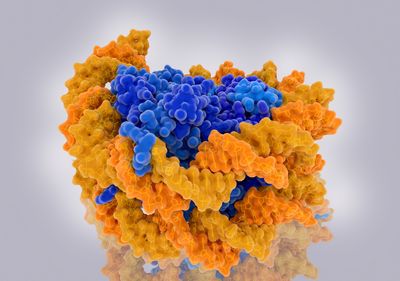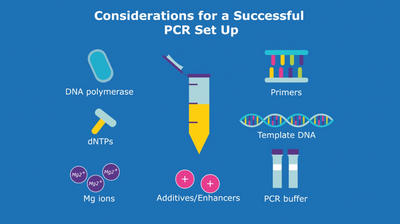ABOVE: © ISTOCK.COM, SELVANEGRA
Senescent cells, those that persist in the body despite having halted cell division, undergo a process called cryptic transcription, whereby they produce RNA transcripts from short sequences nested within individual genes. It is unclear what, if any, functions these transcripts have, and the mechanism behind their expression has long eluded scientists. Now, Payel Sen, a molecular biologist at the National Institute on Aging within the National Institutes of Health (NIH), and her colleagues have begun to unravel how epigenetic changes regulate cryptic transcription, though questions remain. In a Nature Aging paper from March 30, the team revealed that modified histones—the proteins around which DNA is tightly wound in a chromosome—loosen their grip on DNA, potentially allowing the so-called cryptic sites inside genes to be spuriously transcribed.
See “hCINAP Protein Key to Cellular Senescence: Study”
Cryptic transcription by senescent cells was first observed in yeast and worms and later confirmed in mammalian cells. While its function, especially in mammalian cells, has yet to be fully demystified, cryptic transcription may have harmful consequences: Yeast cells lived longer when cryptic transcription was suppressed. Sen speculates that the transcripts might be translated into small proteins, given that they contain a five-prime cap, a feature that permits protein synthesis. Alternatively, she argues that these transcripts may represent “transcription noise” and merely “use up necessary resources in the cell,” reducing the efficiency of aging cells.
Francesco Neri, a molecular biologist at the University of Turin in Italy who was not involved with the work, tells The Scientist in an email that he speculates these transcripts could serve as “detrimental RNAs and/or truncated proteins that may interfere with cellular processes.”
Studying how and why these spurious transcripts are produced in senescent cells as well as their impact on the cell itself could hold important implications for aging and longevity research—determining whether these aging cells grow less efficiently or produce harmful small proteins may ultimately lead to new methods to prolong youthfulness. With many open questions about cryptic RNAs in mammals, Sen and her colleagues set out to decode the epigenetic modifications that drive their synthesis.
Researchers have struggled to unravel what causes cryptic transcription in human cells because cryptic transcripts are difficult to detect and distinguish from other RNA transcripts with traditional RNA sequencing methods. The team turned to a precision nuclear run-on sequencing technique called PRO-cap, which allowed them to determine the start site of transcription in DNA by sequencing the corresponding first few bases in the RNA. With this technique, biotin-labelled nucleotides are added to growing RNA strands, abruptly terminating transcription. These biotin labels serve as markers that discriminate newly formed RNA from older, trimmed transcripts that could not be used to determine the transcription start site.
The researchers generated young and senescent cohorts of cells in the lab using the same human lung cell line by growing the senescent cohort for 50 more rounds of division than the young cohort. Using PRO-cap, the team found that cryptic transcripts were produced at similar levels in both young and senescent cells, suggesting that cryptic transcription occurs throughout a cell’s life. Nonetheless, the researchers identified numerous cryptic sites that were unique to senescent cells that could have age-related functions. Neri says it’s tempting to consider cryptic transcription as a “hallmark of aging.”
By closely examining the genes that contained cryptic sites in senescent cells, the team found that the genes were longer than the average human gene, largely because they contained longer introns. This added length may mean prolonged contact between the RNA polymerase and the DNA strand, increasing the chances of spurious transcription.
These studies were performed using cells cultured in the lab, but the team needed to confirm that cryptic transcription occurs in animals as well. Repeating the study in liver cells taken from mice, the team found that cells from older mice (22–24 months) had greater levels of cryptic transcription than young mice (2–4 months). In a similar fashion to the human lung cells, the mouse genes containing these cryptic sites were longer than average. Intriguingly, cryptic sites were almost exclusively found in cells from female mice. However, female mice were three months older than male mice in this study, which complicates interpretation. Sen argues it’s not a huge age difference and notes that a previous study also found sex differences in cryptic transcription within mouse stem cells.
See “Epigenetic Manipulations Can Accelerate or Reverse Aging in Mice”
Many of these long genes encode proteins found at the cell surface, including ones involved in cell-to-cell adhesion, communication, and signaling, but the team still needs to determine whether that’s a meaningful correlation and whether cryptic transcription interferes with membrane proteins in some way. To do so, Sen aims to decipher whether cryptic transcription occurs at specific genes in a regulated fashion or predominantly at long genes as a side effect of dysregulation. She notes the next step would be to assess whether different groups of cryptic sites are transcribed in separate cell types, as this would support the hypothesis that cryptic sites are regulated. Indeed, Neri mentions that other classes of cryptic sites have been observed in separate studies.
Having identified over 350 cryptic sites in human senescent cells, the researchers then probed the mechanisms driving the process in their cultured human lung cells. In particular, they sought to determine if chemical modifications to histones that loosened their grasp on DNA could have primed these sites for transcription. The team performed chromatin immunoprecipitation, a technique that isolates DNA from cells and shears it, producing fragments that remain bound to histones. These fragments can then be sequestered for analysis using histone-specific antibodies. Sen and her colleagues studied fragments containing cryptic sites and compared the levels of histone methylation, which winds up DNA and switches it “off” by making it unavailable for transcription, with the levels of histone acetylation, which unwinds DNA and allows transcription to occur.
When the researchers probed the specific pattern of histone methylation at human cryptic sites, they found that it matches the patterns discovered earlier in yeast and worms. Senescent cells had more acetylated “on” histones and fewer methylated “off” ones, suggesting histone modifications seemingly correlated with cell age expose cryptic sites that are normally hidden in young cells. Sen argues that “erosion of the epigenome” at cryptic sites associated with aging in senescent cells could boost spurious transcription. Although histone methylation decreased overall in senescent cells, the team observed a specific pattern of increased methylation on histone 3. This pattern is normally seen at the start sites of transcription at sequences known as promoters and provides further support that epigenetic changes drive cryptic transcription.







